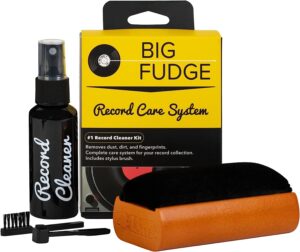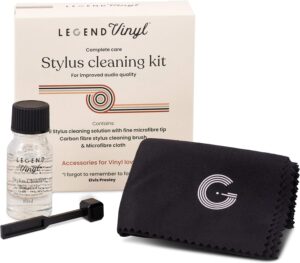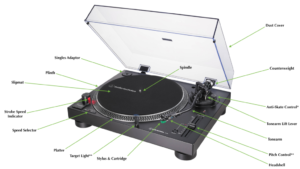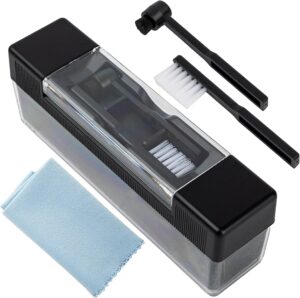Introduction – How To Choose A Record Player
The resurgence of vinyl records in the 21st century
As we step into a digitized world, something incredible is happening in music. Vinyl records are making a resounding comeback, bringing a nostalgic charm that music lovers find hard to resist. It’s like a time machine transporting us back to when listening to music was more of a ritual, where the tactile experience of placing a record on the turntable and watching it spin was almost as satisfying as the melodies that filled the air.
The charm of vinyl and its distinct sound quality
The beauty of vinyl goes beyond nostalgia. There’s an undeniable magic in a vinyl record’s rich, warm sound that digital formats struggle to replicate. Vinyl creates a listening experience, an immersive journey that seems to have a soul of its own. It’s not just about the music, the crackles, the album art, the liner notes, the whole experience.
The Anatomy of a Vinyl Turntable
Understanding key parts: the platter, stylus, cartridge, tonearm, and preamp
Before we venture deeper into the world of vinyl, it’s essential to understand the anatomy of a vinyl turntable. Each turntable consists of several vital components. The platter is where the record sits and spins. The stylus, often called the needle, traces the grooves on the record. The cartridge, mounted on the tonearm, houses the stylus. The tonearm’s role is to keep the stylus positioned correctly. Lastly, the preamp amplifies the music signals for playback.
Importance of each part in delivering optimal sound
Each component is crucial in delivering the sound quality unique to vinyl. A well-balanced tonearm and a precise stylus ensure accurate tracking of the record’s grooves. The cartridge’s quality dramatically affects the signal and, thus, the sound produced. A well-designed and adequately isolated platter minimizes vibrations, which can distort the sound. Finally, a good preamp faithfully amplifies the signal without adding unwanted noise.
Best-Selling Vinyl Turntables on Amazon










Disclosure: As an Amazon Associate, I earn from qualifying purchases.
How to Choose the Perfect Vinyl Turntable
Factors to consider: sound quality, price, build quality, brand reputation
Choosing a suitable turntable involves considering several factors. Prioritize sound quality and view price, build quality and brand reputation. Vinyl turntables range from budget-friendly models to high-end options costing thousands of dollars. However, expensive doesn’t always mean better. Research, read reviews, and listen when possible before making your choice.
Detailed comparison of automatic versus manual turntables
When choosing a turntable, you’ll come across terms like “automatic” and “manual.” An automatic turntable handles the needle dropping and returning on its own, while manual turntables require you to place the stylus on the record manually. Manual turntables often provide better sound quality as they have fewer mechanical parts that can introduce noise or vibrations.
Direct drive versus belt drive turntables
You’ll also need to decide between direct drive and belt drive turntables. Direct-drive turntables offer more consistent speeds and are typically more durable, while belt-drive turntables are known for better sound quality as the belt can absorb unwanted motor vibrations.
Top Vinyl Turntable Brands to Consider
Review of well-regarded brands: Technics, Audio-Technica, Rega, Pro-Ject
There are numerous turntable brands to consider, including well-regarded names like Technics, Audio-Technica, Rega, and Pro-Ject. Technics is renowned for its high-quality direct-drive turntables, while Audio-Technica offers a range of budget-friendly to professional turntables. Rega and Pro-Ject are famous for their excellent build quality and great sound.
Features and pros and cons of each brand
Each brand has its unique strengths and potential drawbacks. Technic turntables are durable and reliable but can be pricy. Audio-Technica offers great value but some models might lack in build quality. Rega and Pro-Ject turntables deliver excellent sound and build, but their minimalist design might lack some features found in other brands.
Maintaining Your Vinyl Turntable for Longevity
Importance of regular cleaning and proper handling
Maintaining your vinyl turntable is crucial for its longevity and optimal performance. Regular cleaning and proper handling not only ensure great sound but also help protect your vinyl records from damage. Use a soft cloth or a specialized brush to clean your turntable regularly.
Recommended cleaning tools and methods
Use an anti-static brush to remove dust from your vinyl records and a stylus cleaner for the needle. Consider a vinyl cleaning solution and a microfiber cloth for a deep clean of your records. Remember to handle your records by the edges to avoid oils from your hands getting on the playing surface.
Replacing parts: when and how to change your stylus and belt
Over time, you may need to replace certain parts, like the stylus and the belt. A worn-out stylus can damage your records, so replace it according to the manufacturer’s recommendation or if you notice a degradation in sound quality. Similarly, replace the belt if you notice any speed inconsistencies or if it looks worn out.
Enhancing Your Vinyl Experience: Must-have Accessories
Essential accessories for vinyl enthusiasts: anti-static brushes, vinyl cleaners, stylus cleaners
To enhance your vinyl experience, consider getting a few accessories. An anti-static brush is essential for keeping your records dust-free. A vinyl cleaner will help keep your records in top shape, and a stylus cleaner will ensure your needle is ready to play your favorite tunes.
 |
 |
|
| Vinyl Record Anti Static Brushes | Vinyl Record Cleaning Kits | Vinyl Record Stylus Cleaners |
High-quality speakers for vinyl turntables: a brief guide
Great speakers are just as crucial as the turntable itself. The speakers should match the quality of your turntable for a well-balanced sound. Consider the size of your room and the type of music you usually listen to when choosing speakers.
Creating Your Own Vinyl Sanctuary: Setting Up a Turntable
Correct placement and isolation of a turntable for best sound
Setting up your turntable correctly is crucial for achieving the best sound. Place your turntable on a stable, flat surface away from speakers to avoid vibrations. Use isolation feet or stands if necessary to further reduce vibrations.
Tips for setting up speakers
When setting up your speakers, position them at ear level and angle them towards your listening position. Keep them away from walls and corners to avoid reflections that can muddy the sound.
Suggestions for acoustically treating your space
If possible, consider acoustically treating your space. Use rugs, curtains, or specialized acoustic panels to absorb sound reflections and enhance quality.
Encouraging newcomers to start their vinyl journey
To all newcomers, I encourage you to embark on this vinyl journey. Don’t be intimidated by the seemingly complex world of turntables and vinyl. Start with a basic setup, learn the ropes, and gradually immerse yourself in this incredibly rewarding hobby.
Call to Action
Feel free to share your vinyl experiences, favorite turntables, or vinyl records in the comments. And don’t forget to follow us for more content about vinyl records and turntables. You’ll find links to related articles or products below.
FAQ
1. How often should I replace the stylus on my turntable?
Typically, a stylus should be replaced every 1,000 to 2,500 hours of playback.
2. How do I know if my turntable’s belt needs replacing?
If your turntable’s speed is inconsistent or if the belt looks worn or stretched, it may be time to replace it.
3. What’s the difference between a direct drive and a belt drive turntable?
In a direct drive turntable, the platter is directly attached to the motor, which can result in more consistent speeds. Belt drive turntables use a belt to connect the motor to the platter, which can absorb motor vibrations and result in better sound quality.
4. Can I use any speakers with my turntable?
While any speakers can technically work with a turntable, for the best sound quality, it’s recommended to use high-quality speakers that match the quality of your turntable.
5. Can a bad stylus ruin records?
Yes, a worn-out or damaged stylus can cause damage to your records. Regularly inspect your stylus for wear and replace it as the manufacturer recommends.
Conclusion
The timeless allure of vinyl and the joy of owning a turntable
The allure of vinyl is timeless, and the joy of owning a turntable is unparalleled. It’s more than just a way to listen to music; it’s an experience, a hobby, a journey. The warm sound, the tactile engagement, the beautiful album art, all combine to create a truly unique and satisfying experience.

